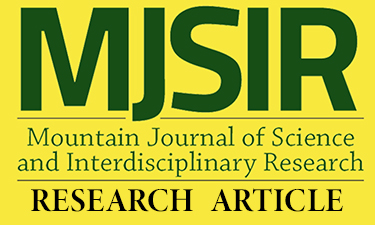Antibiotic Residue Screening in Liver, Kidney, and Muscle Tissues of Non-Monitored Poultry Products, Cull-broiler and Cull, Sold in La Trinidad, Benguet
Main Article Content
Abstract
Cull-broiler and cull are popular poultry meat products in Cordillera Administrative Region (CAR), Philippines but these are not being monitored by authorities for antibiotic residue. This antibiotic residue could pose a direct threat to consumer’s health; thus, this study deemed it necessary to detect the presence of antibiotic residue in the liver, kidney and muscle tissues of cull-broiler and cull being sold in La Trinidad, Benguet using disc diffusion technique or the Kirby-Bauer Disc Method. Results revealed presence of antibiotic residues in the three tissues of cull-broiler. The liver tissue samples had the highest number with positive results against the three test bacteria. This result implies the highest incidence of antibiotic residue in liver tissues followed by kidney and least in muscles. Additionally, cull-broiler has greater incidence of antibiotic residue than cull. Also, there is a significant difference in the level of antibiotic residue present between the tissues of cull-broiler and cull, as shown by the mean diameter (mm) of inhibition zone. Tissues of cull-broiler had the widest mean zone of inhibition as compared to the tissue of culled chicken. Moreover, the zone of inhibition is significantly affected by the type of chicken and the type of tissue indicating that the level of antibiotic residues depends on the type of chicken and the type of tissue. Though the presence of antibiotic residue in the different tissues is relatively small, it still indicates the potential for public health risk. Concerned agencies should not only check broiler for the presence of antibiotic residue but should also include cull-broiler and cull chicken sold in the market.
Article Details
References
Al-Ghamdi, M.S., Al- Mustafa, Z.H., El-Morsy, F., Haider, I. & Essa, H. (2000). Residues of Tetracycline Compounds in Poultry Products in the Eastern Province of Saudi Arabia. Public Health, 114:300-304.
Coyle, M.B. et al. (2005) Manual of Antimicrobial Susceptibility Testing. American Society for Microbiology.
Donoghue, D.J. (2003). Antibiotic Residues in Poultry Tissues and Legs. Human health concerns? Poultry Sci., 82: 618-621.
Ezenduka, E. V., Ike, O.S. & Anaelom, N.J. (2014). Rapid detection of antimicrobial residues in poultry:, A consequence of non-prudent use of antimicrobials. Department of Veterinary Public Health and Preventive Medicine, University of Nigeria, Nsukka, Nigeria. Vol. 6, No.2, 149-152.
Hakem, A. (ex. Akam), Titouche, Y., Houali, K., Yabrir, B., Malki, O., Chenouf, N., Yahiaoui, S., Labiad, M., Ghenim, H., Kechin-Bounar, S. Chirila, F., Lapusan, A., Fit, N. (2013). Screening of antibiotic residues in poultry meat by microbiological methods. Bulletin UASVM, Veterinary Medicine, 70(1). Print ISSN 18435270, Electronic ISSN 1843-5378.
Hind, E., Adil, E., Salman, M. & Samah, A.E.L. (2014). Screening of Antibiotic Residues in Poultry Liver, Kidney and Muscle in Khartoum State, Sudan Hind, University of Bahri, College of Veterinary Medicine, Sudan 2 Ministry of Irrigation, Agriculture and animal welfare, Khartoum.
Hudzicki, J. (2009). Kirby-bauer disk diffusion susceptibility test protocol.
Mohamed K. (2014). Detection and Presumptive Identification of Antibiotic Residues in Poultry Meat by Using FPT. Department of Food Hygiene,Faculty of Veterinary Medicine, Aswan University, 81528 Aswan, Egypt. Global Journal of Pharmacology 8 (2): 160-165, 2014
ISSN 1992-0075 © IDOSI Publications, 2014 DOI: 10.5829/idosi.gjp.2014.8.2.82307
National Office of Animal Health (NOAH). (2016). Retrieved at http://www.noahcompendium.co.uk /Compendium/Overview. Accessed August 2016
Pavlov, A., Lashev, L., Vachin, I., & Rusev, V. (2008). Residues of antimicrobial drugs in chicken meat and offals. Faculty of Veterinary Medicine, Trakia University, Stara Zagora. Trakia Journal of Sciences, Vol. 6, Suppl. 1, pp 23-25, 2008. Copyright © 2007 Trakia University ISSN 13121723
Porter, R.S., Kaplan, J.L., & Merck & Co. (2011). The Merck manual of diagnosis and therapy.
Shahid, M.A., Siddique, M., Sajjad, U. R., Sajid, H. & Hussain, A. (2007). Evaluation of antimicrobial growth inhibition assay as a screening test for the presence of antibiotic residues in poultry meat. American Journal of Food and Technology, 2(5): 457-461
Swatantra, S., Shukla, S., Tandia, N., Kumar, N. & Paliwal, R. (2014). Antibiotic residues: a global challenge. Pharma science monitor an international journal of pharmaceutical sciences. Retrieved at http://www.pharmasm.com Pharma Science Monitor 5 (3), Jul-Sep 2014. Impact factor: 0.3397/ICV: 4.10
Ward, T.J. & Farris III, A.B. (2001). Chiral Separations Using the Macrocyclic Antibiotics: A Review. J. Chromatogr. A 906, 73-89.

